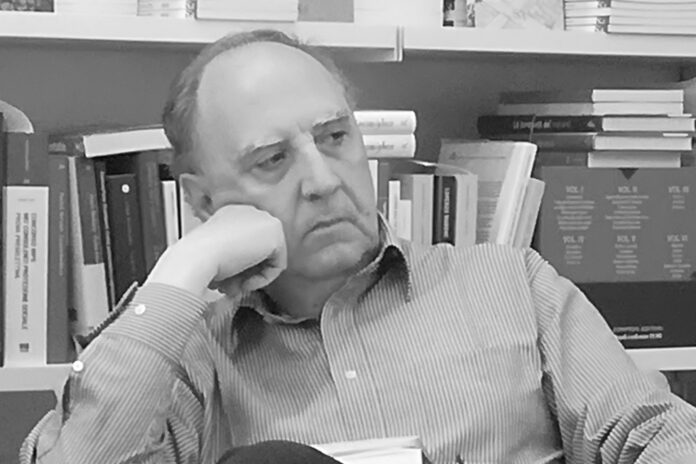Aldo Gerbino is a poet who moves everything: thoughts, moods, memories, perspectives, hopes, “perverse nostalgia”. He does this, simultaneously with the outside world, from “the late cicada among the sugary reeds” to the cosmos known to Lupin, the elderly wolf dog, the protagonist. Also in this case, Gerbino lets his humanism spread, with naturalness and a language that absolutely belongs to him. A humanism which is far from rational artifices. His rationality becomes faithful and docile support of his emotional drive. And this comes out chilled and quietly explosive, as if it were an implosion. A modesty that would require sacrifice, were it not surprisingly nourished by an ancient and modern Mediterranean culture that has turned into an expressive and “biological plenitude”. Thoughts, images, feelings, cultured references (natural sciences, etc.) come together in a single conceptual and poetic terrain. In relation to each of these elements, their pulsional “ontogenesis” seems to be diluting. In reality, it is immediately enriched by a “phylogenetic” and polyvalent flow which becomes, in turn, the ontogenesis’s character of Gerbino’s poetry. And then around Lupin the shrubs, the croaking of an amphibian, the flames of Noctiluca Scintillans, the uncertain glow of the milk-like nudibranchs merge with the taciturn pain, with the thick hair and with the wanderng orbit that is Lupin’s house. An atmosphere almost in the “De Rerum Natura” style in which the force of feeling in all its humid ramifications is imposed – not with upheavals, but with the regular alternation of systole and diastole. The juice of moods and words is dense and intense, with shots of icasticity. Gerbino’s familiarity with art makes him a painter and sculptor in poetry. Till to make us think of the “tactile values” theorized by Bernard Berenson.
ALDO GERBINO
Lupin Lying in the Grass
Lupin lies abandoned on the grass crowning him.
His grave, very human head holds up tremulous wide pupils
rotating in a biological plenitude, under a cosmos
familiar to him, while an ellipse imitates his beloved figures.
Lupine is an old wolf dog: leaning on the threshold of the Tyrrhenian Sea
he strongly hugs the whole of the world: facts, people, feelings,
irritations, joys. Everything appears to him in the faces of his humans.
Wandering, dangling, by the rectangle of the pool,
the orbit is his home; the silence that inhabits him flows among shrubs
and the fingers of those who caress him. He goes on making his craft
and his thick fur vibrates, painfully weighing on his front legs
and then uneasily trying to tow his back still full of the voices
of the camerlingos, of the funerary fragments of the thòlos, of the
Byzantine mists, fossil stones and fatal plagues filtered by the trapping tonnare.
But a moonlight spreads on his head,
he tries to shelter in a tiny wooden house,
while an amphibian is croaking of, in the dry rebuke
of a late cicada among sugary reeds. As if it were mine too,
I recognized your silent pain as any pure creature does,
unawarely sharing the greedy weight of the afflicting days.
A subtle grace rests in his unawareness:
a talkative mutism, the death’s viscous dust
confused with torrential waters, drains, while rocks are breathing,
and nocturnal birds, too, and marine flames of Noctiluca scintillans
up to the uncertain glow of milk-like nudibranchs,
snails, wicked nostalgia.
Balestrate, Palermo, end of August, 2020
(Translation into English by Carmelo Strano)
Lupin adagiato sull’erba
Lupin s’è abbandonato sull’erba. E l’erba gli fa da corona.
La testa grave, umanissima, regge tremule ampie pupille
rotanti in una plenitudine biologica, sotto un cosmo
a lui domestico, mentre un’ellisse imita le sue amate figure.
Lupin è un vecchio cane lupo: sporto alle soglie del Tirreno
stringe a sé l’interezza del mondo: fatti, persone, sentimenti,
irritazioni, gioie. Tutto gli appare nel volto dei suoi umani.
Bighellona, ciondolante, presso il rettangolo della piscina,
l’orbita è la sua casa; il silenzio che lo abita cola tra arbusti,
tra le dita di chi lo carezza. Continua il suo mestiere vibrando
col folto pelame, gravando penosamente sulle zampe anteriori
per poi trainare, con fatica, il dorso ancora ricolmo delle voci
dei camerlenghi, dei frammenti funerei di thòlos, di brume
bizantine, pietre fossili e mortali piaghe filtrate dalle tonnare.
Ristagna, comunque, un chiarore lunare sul suo capo,
mentre si protegge in una minuscola casa di legno,
al gracidio di un anfibio, nel secco rimbrotto
d’una cicala tardiva tra canneti zuccherini. Ho riconosciuto
anche mio, il suo taciturno dolore; come ogni pura creatura
condivide, ignara, l’ingordo peso dei giorni appenanti.
In tale sua inconsapevolezza vi riposa una sottile grazia:
un mutismo loquace, il pulviscolo viscoso della morte
confuso ad acque torrentizie, scoli, al respiro di rocce,
uccelli notturni, marine fiammelle di Noctiluca scintillans
fino all’incerto brillio di lattescenti nudibranchs,
chiocciole, perverse nostalgie.
Balestrate, fine agosto 2020
ALDO GERBINO was born in Milano, in 1947, he is a morphologist, Emeritus of the Italian Society of Experimental Biology and former full Professor of Histology and Embryology at the University of Palermo, where he lives. Critic, author for RAI (Il tempo della terra, 1985). As a poet he published different collections, such as Jünger’s Beetle and Deceiving Waiting (Novecento, 1995; 1997); It will not make noise (Spirali, 1998); Gessi (Sciascia-Scheiwiller, 1999); The uncertain swimmer (Sciascia, 2002); Crossing the Gobi (Spirali, 2006); To the letter r, in “Almanacco dello Specchio” (Mondadori, 2011); Mercurial comets, feathers (Algra, 2016); That’s not all (Club di Milano ~ Spirali, 2018). Among the numerous essays he published: Sicilian Nativity Scenes (Scheiwiller, 1998); Benvenuto Cellini (Spirali, 2006); Sicily, thousand years poetry (Sciascia, 2001); Cameos (Pungitopo, 2015). Other texts have been appeared “New Topics”, “Gallery”, “Corriere della Sera”, “Gradiva”, “Poeti e Poesia”, “Il sarto di Ulm”.








